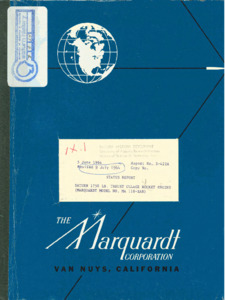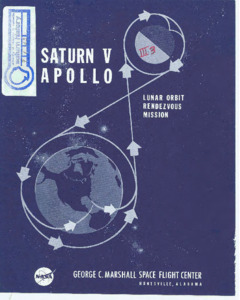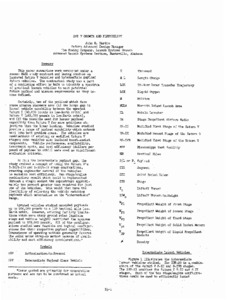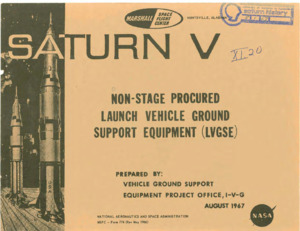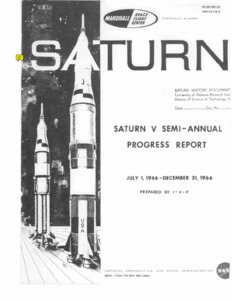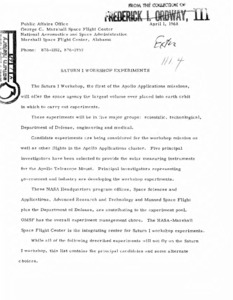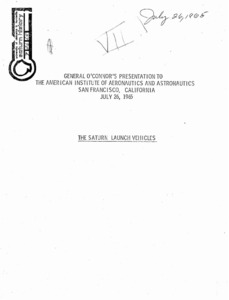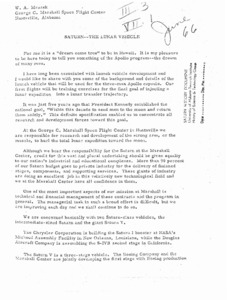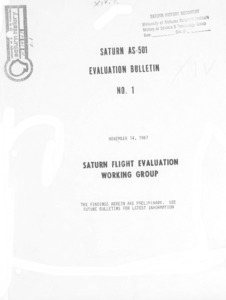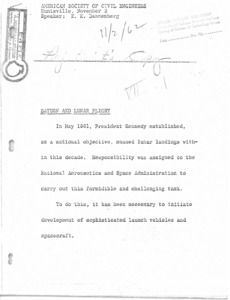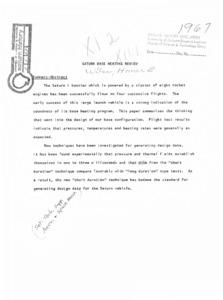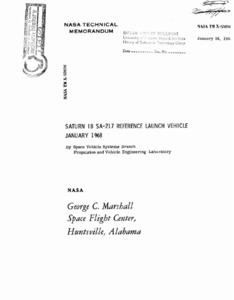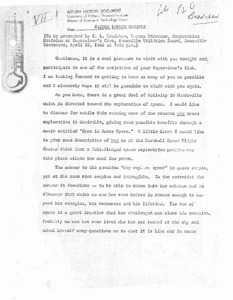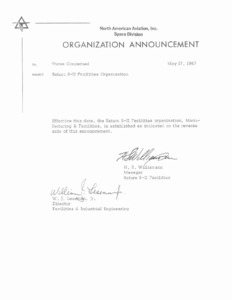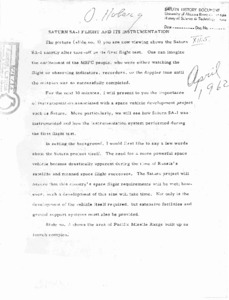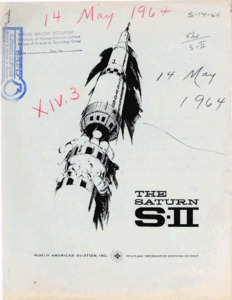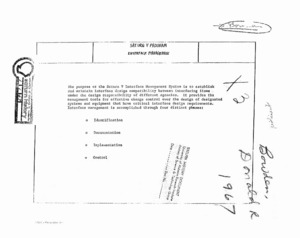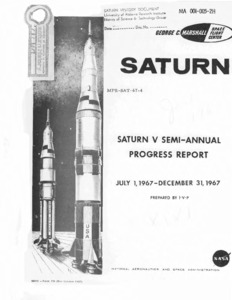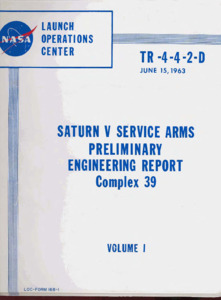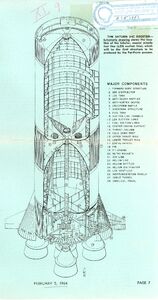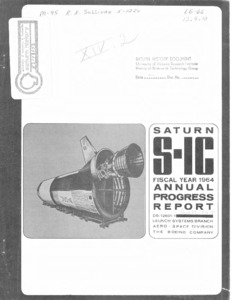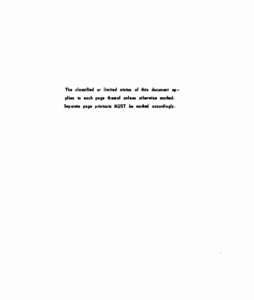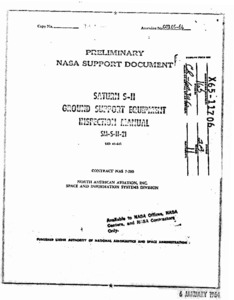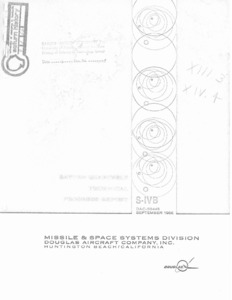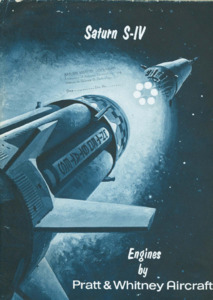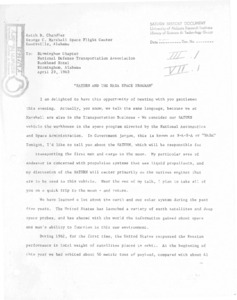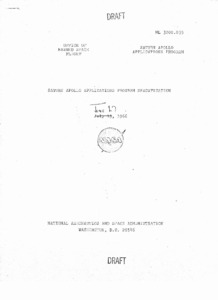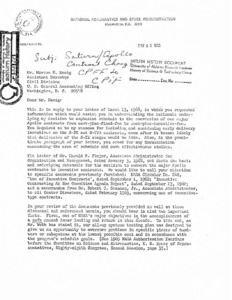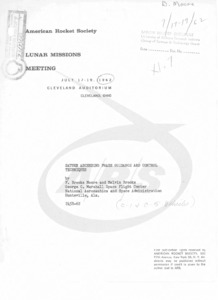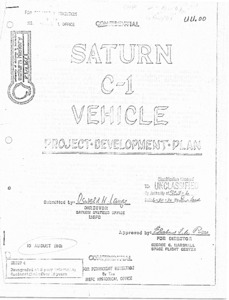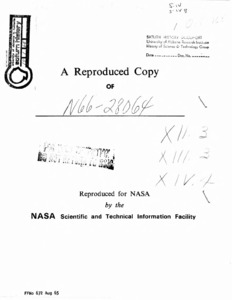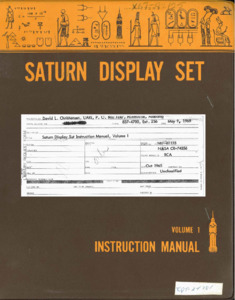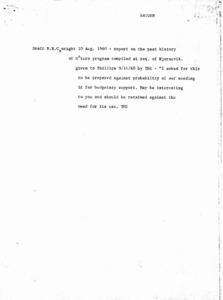
Browse Items (1965 total)
Sort by:
-
"Saturn 1750 LB. Thrust ullage rocket engine."
Report detailing the progress and status of the RDT-12 engines under construction. -
"Saturn V America's moon rocket."
Diagram that displays the Saturn V rocket with a page beneath detailing the function of each stage. -
"Saturn V Apollo flight configuration."
Diagram displaying the internal rooms, pieces and functions of the Saturn V as well as the space-suits of the astronauts. -
"Saturn V Apollo lunar orbit rendezvous mission."
Diagram explaining the process of a lunar mission from liftoff to recovery. -
"Sat V growth and flexibility."
This paper summarizes work conducted under a recent NASA study contract and Boeing studies on improved Saturn V vehicles and intermediate payload Saturn vehicles. The contractual study was a part of a continuing effort by NASA to identify a spectrum of practical launch vehicles to meet potential future payload and mission requirements as they become defined.; UAHuntsville's Saturn V finding aid has the title as: Saturn V Growth and Flexibility, by J.E. Martin.; Preferred Citation: [Identification of item] Saturn V Collection, Dept. of Archives/Special Collections, M. Louis Salmon Library, University of Alabama in Huntsville, Huntsville, AL. -
"Saturn V : non-stage procured launch vehicle ground support equipment."
The functions, authority, management relationships, and responsibilities of the Launch Vehicle Ground Support Equipment Project Office are described. Functions and examples of non-stage procured Launch Vehicle Ground Support Equipment (LVGSE) are described and illustrated. -
"Saturn V inboard profile : Launch escape system flight separation."
Diagram displaying the launch escape system flight separation in progress. -
"Saturn V semi-annual progress report July-December, 1966."
MA-001-00202H.; MPR-SAT V 66-3.; ABSTRACT: This Saturn V Semi-Annual Progress report describes progress and major achievements from July 1, 1966, through December 31, 1966, in the Saturn V Program. -
"Saturn I workshop experiments."
April 1, 1968.; Stamped on first page is From the Archives of Frederick I. Ordway, III. -
"The Saturn launch vehicles."
General O'Connor's presentation to the American Institute of Aeronautics and Astronautics. Centers around saturn space vehicles and makes references to slides. -
"The Saturn launch vehicle family."
Presentation focusing on the history of Saturn V's engineering history and crew. -
"Saturn -- the lunar vehicle."
Aerospace Workshop, University of Hawaii.; Includes references to slides. -
Saturn AS-501 evaluation bulletin No. 1, November 14, 1967.
The findings herein are the results of the combined evaluation efforts of the various Laboratories of Research and Development Operations at MFSC, The Boeing Company, North American Rockwell/Space Division, Douglas Aircraft Company, International Business Machines, and Rocketdyne. -
Saturn and lunar flight.
Speech by K.K. Dannenberg at American Society of Civil Engineers, Huntsville, November 2.; Projectionist's copy (photocopy) - slide numbers are included. -
"Saturn Apollo guidance error estimation."
A brief sketch of the development of the equations for a weighted least squares estimator is given, the equations for both collective and recursive estimators being included. Four possible problem sources that may be encountered in the application of the estimator are identified. Various "success" parameters are defined in an attempt to predict the success with which, the method has been applied. The application of the estimation technique to the problem of computing various error parameters associated with the ST-124M guidance platform is described with the numerical results obtained using a manufactured data case are presented. These results are used to form conclusions about the effectiveness of the "success" parameters and preferred approaches to the problem of system evaluation using techniques of estimation theory. -
"Saturn base heating review."
The Saturn I booster which is powered by a cluster of eight rocket engines has been successfully flown on four successive flights. The early success of this large launch vehicle is a strong indication of the soundness of its base heating program. This paper summarizes the thinking that went into the design of our base configuration. Flight test results indicate that pressures, temperatures and heating rates were generally as expected. New techniques have been investigated for generating design data. It has been found experimentally that pressure and thermal fields establish themselves in one to three milliseconds and that data from the "short duration" technique compare favorably with "long duration" type tests. As a result, the new "short duration" technique has become the standard for generating design data for the Saturn vehicle. -
"Saturn IB SA-217 reference launch vehicle."
This document contains a definition of a reference Saturn IB launch vehicle designated SA-217. The Saturn IB SA-217 is a projected reference vehicle, based on Saturn IB SA-212, incorporating the latest proposed product improvements. The two-stage payload capability of this vehicle to a 100-nautical-mile circular orbit is 44,965 pounds. The Saturn IB SA-217 launch vehicle is to be used as the baseline vehicle for advanced studies requiring the use of the standard or modified Saturn IB launch vehicle. This vehicle definition does not necessarily represent approved changes to any specific vehicle. This document supersedes the Saturn IB SA-213 reference Launch Vehicle, described in memorandum R-P&VE-DIR-65-92. -
"Saturn launch vehicle presentation."
Speech to be presented by C. L. Bradshaw, Deputy Director, Computation Division at Supervisor's Club, Knoxville Utilities Board. Speech praising the progress of space-based technologies and advancements. -
"Saturn S-II facilities organization."
Organizational chart for the Saturn II facilities. -
"Saturn SA-1 flight and its instrumentation."
Presentation focusing on empahsising the importance of space programs such as Saturn. -
"The Saturn S-II."
The S-II is the second stage of NASA's Apollo moon-landing rocket - the giant Saturn V. The most powerful hydrogen-fueled booster under production, the S-II is destined for Apollo manned lunar missions and will help power three Americans to the moon. The S-II is being developed and manufactured at Seal Beach, Calif., by North American's Space and Information Systems Division, Downey, Calif., under the technical direction of NASA's Marshall Space Flight Center, Huntsville, Ala. -
"Saturn V interface management."
The purpose of the Saturn V Interface Management System is to establish and maintain interface design compatibility between interfacing items under the design responsibility of different agencies. It provides the management tools for effective change control over the design of designated systems and equipment that have critical interface design requirements. -
"Saturn V semi-annual progress report July - December, 1967."
This Saturn V Semi-Annual Progress Report describes progress and major achievements from July 1, 1967 in the Saturn V Program. -
"Saturn V service arms : preliminary engineering report."
This report presents the manufacturing requirements for fabricating Saturn V service arms and contains design and operating details of the service arms and associated equipment. Part 1 defines the areas of responsibility necessary for the manufacture of Saturn V service arms and associated equipment. Capability requirements, manufacturing processes, special techniques, schedules, and other areas are detailed in Part 1. The manufacturer selected to fabricate the arms and related equipment must meet the requirements (stated in Part 1. Part 2 contains design and operation details of the service arms, Command Module Access Arm, and related equipment used on or in support of the Launcher-Umbilical Tower for the Saturn V Vehicle at Complex 39. The design and construction of all basic arms is similar. Eight service arms are being designed. The arms are being designed to support all umbilical lines necessary to service the various stages of all Saturn V Vehicles. The arms are also being designed to allow personnel access to the vehicle. Some of the arms must be retracted before vehicle lift-off and others will retract following lift-off. This requirement necessitated the design of umbilical disconnect and arm retract devices which would ensure clearance between the arms and vehicle during lift-off. The Command Module Access Arm is a separate design concept. The arm is used only for astronaut access to the Command Module. Part 2 presents the preliminary design directed toward meeting the requirements stated above. -
"Saturn S-IC booster : schematic."
This is page 7 of the Marshall Star : Space Information Digest. -
"Saturn S-IC annual progress report, 1964."
This report encompasses the progress made by The Boeing Company on the Saturn S-IC Program for the fiscal year 1964 (From July 1, 1963 through July 2, 1964). The main objective of this report is to serve as an historical presentation stressing Boeing accomplishments and present capabilities under Contract NAS8-5608. -
"Saturn S-IC annual progress report, 1965."
This Annual Progress Report has been prepared by the Boeing Company to fulfill the requirement under Article XXX, Paragraph A and C, Modification 100 of Contract, NAS8-5608 as amended by NASA letter I-MICH-DB, dated May 19, 1965, B. H. Aldridge to E. S. Olason. Subject: Change of NAS8-5608 to incorporate Quarterly Technical Progress into the Annual Progress Report. -
"Saturn S-II general manual."
This manual contains information covering the second stage of the Saturn V launch vehicle. -
"Saturn S-II ground support equipment inspection manual."
This publication has been prepared to provide preliminary inspection requirements and limitations on all ground support equipment to support the Saturn II stage of the Saturn V launch vehicle. -
"Saturn S-IVB quarterly technical progress report."
Douglas Aircraft Company Report DAC-56445, Saturn S-IVB Quarterly Technical Progress Report, covers design and development progress on the Saturn IB and Saturn V configurations of the S-IVB stage during August and September 1966. This report is prepared for the National Aeronautics and Space Administration under Contract NAS7-101. -
"Saturn S-IV engines."
Folder of information. -
"Saturn and the NASA space program."
Given at the Birmingham Chapter National Defense Transportation Association. Focuses chiefly on moon-missions. -
"Saturn Apollo applications program specification."
This first issue contains only some general provisions for the program and its requirements for the Saturn 1B launch vehicle. -
"Saturn/Apollo contract change : letter from George E. Mueller to Morton E. Henig."
Correspondence letter detailing Mueller's concerns regarding potential issues in the design of the Saturn stages. -
"Saturn ascending phase guidance and control techniques."
Lunar Missions Meeting, July 17-19, 1962. Focuses on the guidence concept under development at the Marshall Space Flight Center -
"Saturn C-1 vehicle project development plan."
The Saturn C-1 space vehicle system is being developed by government agencies at industrial firms under the direction of the National Aeronotics and Space Division -
"Section III of Saturn C-1 vehicle project development plan."
Plan for the development and construction of the Saturn C-1 vehicle. -
"Saturn data summary handbook."
This handbook provides a technical data summary for the Douglas-produced Saturn S-IV and S-IVB stages of the NASA Apollo Program. Material contained in the S-IVB stage of this handbook includes the S-IB and S-V vehicles. This book will be updated as changes and additional information become available. The appendix contains aerospace fluid characteristics, LOX and LH2 vapor pressure curves and a list of non-standard abbreviations. -
"Saturn display set: instruction manual."
The manual comprises a multi-volume set, the contents of which are as follows: VOLUME 1 -- a. Chapter 1 contains a general description of the equipment and its purpose, the physical and functional characteristics, and other pertinent data. b. Chapter 2 describes and illustrates the display set installation considerations. c. Chapter 3 lists and illustrates all operating controls and indicators. Chapter 3 also contains normal and emergency operating instructions. -
"Saturn: draft."
Report on the history of the Saturn program.
